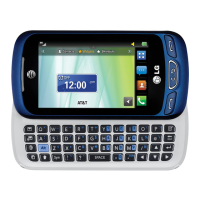
Do you have a question about the LG Xpression 2 and is the answer not in the manual?
| Brand | LG |
|---|---|
| Model | Xpression 2 |
| Operating System | Android |
| RAM | 1 GB |
| Internal Storage | 4 GB |
| Rear Camera | 5 MP |
| Front Camera | VGA |
Details LG limited warranty coverage for the phone and accessories.
Lists exclusions and conditions not covered by the LG limited warranty.
Outlines LG's responsibilities for repair, replacement, or refund under warranty.
Explains consumer rights specific to state laws and their relation to the warranty.
Provides contact information and steps to obtain warranty service for the product.
Identifies and describes the physical parts and buttons of the LG Xpression2 phone.
Illustrates the back of the phone, showing components like the camera lens and SIM card slot.
Details the functions of the physical QWERTY keyboard and its special keys.
Guide to inserting SIM card and battery into the phone.
Instructions on connecting the phone to a power source for charging.
Guide on expanding the phone's storage with a microSD card.
Explains various display indicators and icons found on the phone's screen.
Instructions on initiating calls using the dial pad, recent calls, or contacts.
How to accept or reject calls, including handling call waiting.
Methods for inputting text using the touch pad, including ABC and T9 modes.
Guidance on effectively interacting with the phone's touch-sensitive display.
Explains the function of shortcut keys for quick access to common features.
Managing home screen views and adding interactive widgets for quick access.
Managing and accessing your phone's contact list and favorite contacts.
Customizing the standby screen with frequently used applications or functions.
Accessing quick settings and notifications from the top bar.
Overview of the phone's main menu categories: Phone, Multimedia, My Stuff, and Settings.
Details on synchronizing phone contacts with the AT&T Address Book server.
Steps to add new contact information, including name, number, and email.
Managing contacts for quick access and organizing them into groups.
Assigning phone numbers to speed dial keys for quick dialing.
Copying and deleting contact information between the SIM card and phone.
Functions available while actively on a phone call, like making a second call.
How to accept or reject calls, including handling call waiting.
Setting up and managing multi-party calls for simultaneous conversations.
Creating and sending text and multimedia messages, including inserting files.
Overview of message storage locations like Inbox, Drafts, and Outbox.
Configuring preferences for message alerts, saving, and signatures.
Setting preferences for receiving and sending multimedia messages.
Accessing and managing email accounts on the phone.
Details on GPS navigation, search, and map features for the AT&T Navigator app.
Steps to start the web browser and access the internet.
Explains browser options like Home, Bookmarks, and Landscape View.
Viewing and managing music files by songs, playlists, artist, album, and genre.
Instructions on how to play music tracks and control playback.
Methods for transferring music files from a computer to the phone.
Recording voice memos and sounds using the phone's built-in recorder.
Capturing still images with the phone's camera and its interface.
Recording video clips using the phone's camcorder and its interface.
Viewing and managing photos and videos stored on the phone.
Accessing picture and video files, including creating animated GIFs.
Downloading and using games and applications on the phone.
Creating and saving text memos on the phone.
Accessing audio-related features like the voice recorder.
Managing schedules, events, and holidays.
Performing basic calculations and accessing utility applications.
Using voice recognition for phone functions like calling and checking messages.
Creating, managing, and sending tasks.
Calculating tips, splitting bills, and converting measurements.
Setting alarms and using the world clock feature.
Measuring elapsed time and recording lap times.
Viewing, managing, and transferring files on the phone and memory card.
Basic phone settings like date, time, languages, screen lock, and flight mode.
Managing phone security, PIN codes, locks, and fixed dial numbers.
Customizing ringtones, message tones, alerts, and keypad sounds.
Configuring call forwarding, redial, answer modes, and call waiting/reject.
Managing wireless Bluetooth devices and network connection modes.
Customizing browser experience and managing application settings.
Checking memory usage and setting storage defaults.
Managing software updates, phone info, and accessibility features.
Answers to frequently asked questions about phone operation and potential problems.
Information about the charger adapter for powering the phone.
Details about the USB cable for data transfer and charging.
Information regarding the phone's replaceable battery.
Critical safety warnings regarding phone usage, battery handling, and potential hazards.
Guidelines and information regarding radio frequency exposure limits and compliance.
Recommendations for safe listening practices to prevent hearing damage from audio devices.
General safety information related to wireless handheld phones.
Explains RF signals and FCC guidelines for phone operation.
Proper antenna care and advice for efficient phone operation.
Safety precautions for using the phone charger and battery.
Warnings about potential hazards related to battery misuse and phone operation.
Information from the FDA regarding health effects and safety of wireless phones.
Safety recommendations for using the phone while operating a vehicle.
Definitions for call forwarding, waiting, and conference calls.
Definitions for GPRS, GSM, and Java technology.
Definitions for SIM card functionality and SMS service.
